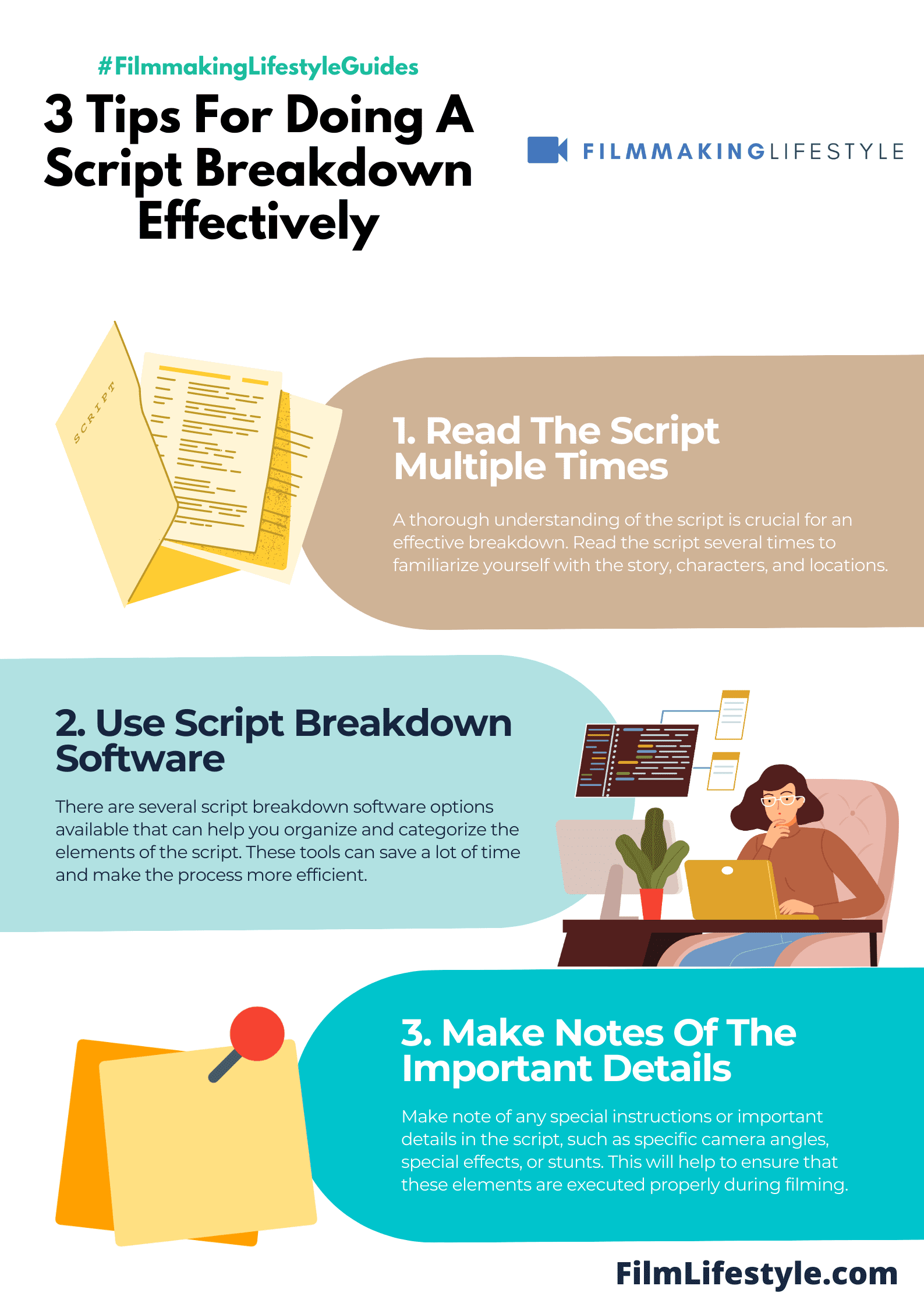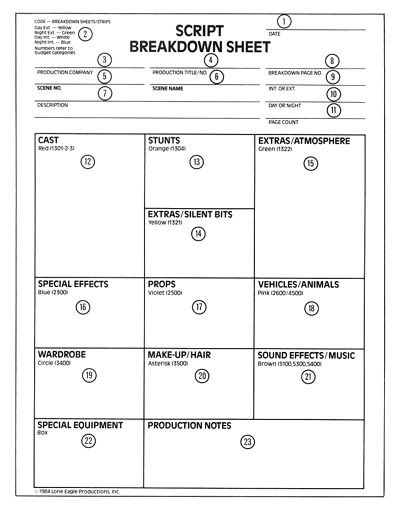Where would the world be without movies?
This is a question that many people have asked themselves since the invention of film.
We take for granted how much we love to go out and see a movie, but it’s important to remember how far back in history this has been going on!
Ever wonder how a movie is made? It all starts with the writer who writes a screenplay. The producer finds the funding for the project and then hires directors, writers, producers, and actors to work on it.
Then there’s editing, sound mixing, and color correction which leads up to release day!
It’s time-intensive and tedious, but it doesn’t have to be! Let me show you how I do it in five easy steps.
SCRIPT BREAKDOWN
What Is Script Breakdown?
Script breakdown is an important process in the filmmaking industry that helps everyone involved know what needs to be done and when.
Script breakdowns are used for both on-set and post-production tasks, including editing, sound design, and marketing plans.
Script breakdowns are a way of ensuring that everyone knows their roles and responsibilities so they can work together effectively to make the final product great.
Diving into the world of film and television production, a script breakdown is our roadmap to visualizing the story before a single frame is shot.
It’s the crucial first step that transforms a screenplay into manageable action items for every department.
We’ll explore how this meticulous process lays the groundwork for budgeting, scheduling, and the intricate dance of logistics that brings a script to life.
Understanding the nuts and bolts of a script breakdown means unlocking the potential of any production.
We’ll guide you through identifying all the elements from cast to props, and show you how it’s the linchpin in pre-production planning.
Stick with us as we delve into the art of dissecting a script, ensuring that nothing’s left to chance when the cameras start rolling.
What Is A Script Breakdown?
A script breakdown is the meticulous process of reviewing the screenplay to identify all the necessary elements to prepare for production.
We analyze every scene to determine which cast members are needed, what locations are to be used, and which props, costumes, and special effects are required.
This phase serves as a crucial bridge between the conceptual and the practical; it’s where the written word starts to find its footing in the tangible world of film production.
It involves going through the script line by line and noting elements that will affect the various departments.
For example, we’ll note a change in location, which requires the art department to design a new set, or a stunt that needs the expertise of a coordinator to plan and execute safely.
Every element noted during the breakdown will impact our budgeting and scheduling, ensuring that all crew members are adequately prepared for the demands of the upcoming shoot.
Through a script breakdown, we also identify potential issues and problem areas before they arise on set.
Say there’s a complex sequence in Inception involving zero gravity; recognizing the technical demands of such a scene early on allows us to allocate the necessary resources, time, and expertise to pull it off.
Similarly, identifying key scenes helps us to prioritize our efforts during the most resource-intensive parts of production.
The Importance Of Script Breakdown In Film And Television Production
Script breakdowns are fundamental in transforming the textual elements of a screenplay into visual storytelling.
It involves a granular analysis that highlights crucial components such as character development arcs and visual metaphors—elements that might be overlooked during a cursory read.
We ensure that every prop, costume, and location enhances the narrative, fostering an immersive experience for the audience.
By dissecting scenes into actionable parts, we’re able to pinpoint the specific requirements for each department.
This meticulous process allows for efficient resource allocation and streamlined communication among the crew.
We dive deep into the technical aspects, recognizing the importance of matching the visual tone of The Godfather with its strong thematic elements or the vibrant energy that pulses through every frame of La La Land.
We leverage script breakdowns to anticipate potential obstacles that could otherwise derail production.
Take a complex sequence involving stunts and special effects—it’s our road map that ensures we’re prepared for the demands of such a scene.
It’s not sufficient to merely understand the logistics; knowing exactly when and how complexities will unfold is pivotal.
Identifying the pivotal scenes and technical requirements early on cannot be understated.
By examining the details that scripts entail, we’re committed to safeguarding the production’s vision and financial viability.
It’s a strategic approach that ensures the final product reflects the initial creative intent, supported by a well-orchestrated behind-the-scenes effort.
The Role Of A Script Breakdown In Budgeting And Scheduling
Creating a film is akin to building a house.
You need a clear plan before you begin, and that’s where a script breakdown enters the scene.
It’s a vital tool that lays the groundwork for how we allocate our budget and schedule our shoots.
Script breakdowns provide a blueprint for production costs.
Identifying all the necessary elements within a script guides us toward a detailed budget.
We can pinpoint exactly how many actors we’ll need, the types of locations required, and the amount of time we’ll spend on each scene.
This foresight allows us to allocate funds strategically, ensuring that we get the most out of every dollar.
Scheduling is another area where script breakdowns prove indispensable.
By dissecting the screenplay, we establish the most efficient shooting order.
Often, this isn’t linear and informed decisions must be made about when to film specific scenes.
We consider factors like actor availability, location permits, and even weather conditions, all of which hinge on a thorough script breakdown.
What’s more, script breakdowns help us pinpoint scenes that need special attention or additional resources.
Whether it’s a complex stunt or a crowd scene demanding extras, we have advanced notice to plan accordingly.
This planning isn’t just about avoiding surprises—it’s about giving ourselves the breathing room to ensure those scenes are executed flawlessly within the envisioned budget and timeframe.
How To Conduct A Script Breakdown
As we continue to explore the ins and outs of film production, understanding how to conduct a script breakdown is
This methodical step-by-step process helps us grasp all the elements that will eventually bring a story like The Godfather to life on screen.
Initially, we read through the screenplay meticulously, focusing on story beats and identifying all the script elements that will require attention during production.
Each element – whether it’s cast, locations, props, wardrobe, or special effects – gets tagged with a unique color.
This color-coded system is not just about aesthetics; it’s an efficient way of visual categorization to reference quickly and easily.
It’s integral to our process, ensuring that nothing slips through the cracks and every cost is accounted for from the get-go.
The next crucial step involves creating a scene-by-scene breakdown, documenting details like cast present, extras needed, special equipment, and any potential stunts or special effects.
Creating a list for each category simplifies the subsequent resource allocation aspect.
For instance, scheduling becomes more straightforward when we know exactly how many days we’ll need an actor or how many scenes require a rain machine.
Finally, merging these breakdowns with the shooting schedule enables us to finetune details further, considering the availability of cast and locations alongside the logistical intricacies of pulling off each day of the shoot.
Software tools can be a real asset here, helping us turn the initial script breakdown into a dynamic document that can evolve as the production requirements adjust.
Understanding how to execute a script breakdown with precision plays a pivotal role in the lifecycle of any film project.
By dissecting scripts into their smallest components, we not only safeguard the project against unforeseen expenses but also craft a roadmap that serves as the foundation for the entire production phase.
The Key Elements To Identify During A Script Breakdown
During a script breakdown, it’s essential to pinpoint various key elements that are pivotal to the production process.
We categorize these into several groups to ensure that nothing slips through the cracks.
Characters and Cast: Identifying all speaking roles and extras is a priority.
We assess the complexity of each character, which influences casting decisions and impacts our ability to schedule scenes efficiently.
Locations: We meticulously chart each location mentioned in the script.
As each setting can drastically change production requirements, it’s critical to know where our scenes will unfold.
Props and Wardrobe: Every item that appears on screen, from a hero prop to a character’s costume, must be accounted for.

This helps us anticipate the logistics of sourcing or creating these items.
Special Effects and Stunts: Whether it’s a simple practical effect or an elaborate stunt sequence, acknowledging these elements early ensures we allocate sufficient budget and preparation time.
Camera and Lighting Requirements: Understanding the visual style of the project guides us in selecting the appropriate camera equipment and designing lighting setups that bring the director’s vision to life.
Sound and Music: We keep a close ear on scenes requiring special audio treatments or musical cues.
This allows us to plan for on-location sound challenges or original score compositions.
By addressing these elements, we’re equipped to dive deeper into the production phase with confidence and precision.
This preparation builds a robust foundation for crafting a visually and narratively cohesive film.
We rely on this level of detail to orchestrate the logistics that transform a script into an engaging cinematic experience.
Script Breakdown – Wrap Up
We’ve seen how vital a meticulous script breakdown is to the filmmaking process.
It’s the roadmap that guides us through the complex terrain of production, ensuring no detail is overlooked.
With this foundation, we’re equipped to tackle the logistical challenges that come with bringing a story to life.
It’s about more than just preparation; it’s about transforming a script into a tangible, captivating experience for audiences everywhere.
Let’s embrace the script breakdown as our essential tool for crafting the extraordinary.
Frequently Asked Questions
What Is A Script Breakdown?
A script breakdown is a thorough analysis of a screenplay in film or television production, where the script is dissected to pinpoint elements such as character development, locations, props, and visual metaphors, aiding in resource allocation and production planning.
Why Are Script Breakdowns Important?
Script breakdowns are vital for streamlining communication among the crew, anticipating challenges, and ensuring that the production stays true to its creative vision while maintaining financial control.
They provide a clear plan for budgeting, scheduling, and managing resources efficiently.
How Do Script Breakdowns Help In Budgeting And Scheduling?
Script breakdowns create a detailed map of production costs, highlighting scenes that require special resources.
They allow producers to allocate funds strategically and establish an efficient shooting order bearing in mind actor availability, location access, and other logistics.
Can Script Breakdowns Affect The Final Product?
Yes, script breakdowns are instrumental in ensuring that the final product aligns with the initial creative intent.
They help prioritize efforts and resources, enabling the production to execute complex scenes without compromising the narrative or visual quality.
What Elements Are Identified In A Script Breakdown?
Key elements identified during a script breakdown include cast and characters, locations, props, wardrobe, special effects, stunts, camera and lighting needs, and sound and music.
Recognizing these aspects is essential for detailed pre-production planning and execution.

Matt Crawford
Related posts
4 Comments
Leave a Reply Cancel reply
This site uses Akismet to reduce spam. Learn how your comment data is processed.



I just read your blog and I’m so amazed by your journey! I love the way you weave journey, anecdotes, and personal experiences together to create a captivating narrative. Keep up the great work
Appreciate it, Burt.
Great piece on script breakdowns. Thanks!
Cheers, Vedo.